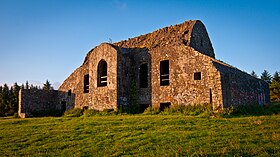Hellfire Club, Dublin
| Montpelier Hill | |
|---|---|
| Hell Fire Club | |

Dawn at the Hell Fire Club on Montpelier Hill, Dublin
|
|
| Highest point | |
| Elevation | 383 m (1,257 ft) |
| Coordinates | 53°15′6.7″N 6°19′49.24″W / 53.251861°N 6.3303444°WCoordinates: 53°15′6.7″N 6°19′49.24″W / 53.251861°N 6.3303444°W |
| Geography | |
| Location | County Dublin, Ireland |
| Parent range | Dublin Mountains |
| OSI/OSNI grid | O120238 |
| Topo map | OSI Discovery No. 50 |
Montpelier Hill (Irish: Cnoc Montpelier) is a 383-metre (1,257-foot) hill in County Dublin, Ireland. It is commonly referred to as the Hell Fire Club (Irish: Club Thine Ifrinn), the popular name given to the ruined building at the summit. This building – a hunting lodge built around 1725 by William Conolly – was originally called Mount Pelier and since its construction the hill has also gone by the same name. The building and hill were respectively known locally as 'The Brass Castle' and 'Bevan's Hill', but the original Irish name of the hill is no longer known although the historian and archaeologist Patrick Healy has suggested that the hill is the place known as Suide Uí Ceallaig or Suidi Celi in the Crede Mihi, the twelfth century diocesan register book of the Archbishops of Dublin.
Montpelier is the closest to Dublin city of the group of mountains – along with Killakee, Featherbed Bog, Kippure, Seefingan, Corrig, Seahan, Ballymorefinn, Carrigeenoura and Slievenabawnogue – that form the ridge that bounds the Glenasmole valley. On the slopes is a forestry plantation, known as Hell Fire Wood, which consists of Sitka spruce, larch and beech.
Originally there was a cairn with a prehistoric passage grave on the summit. Stones from the cairn were taken and used in the construction of Mount Pelier lodge. Shortly after completion, a storm blew the roof off. Local superstition attributed this incident to the work of the Devil, a punishment for interfering with the cairn. Montpelier Hill has since become associated with numerous paranormal events.
Members of the Irish Hell Fire Club, which was active in the years 1735 to 1741, used Mount Pelier lodge as a meeting place. Stories of wild behaviour and and occult practices and demonic manifestations have become part of the local lore over the years. The original name of the lodge has been displaced and the building is generally known as the Hell Fire Club. When the lodge was damaged by fire, the members of the Hell Fire Club relocated down the hill to the nearby Stewards House for a brief period. This building also has a reputation for being haunted, most notably by a massive black cat.
...
Wikipedia

